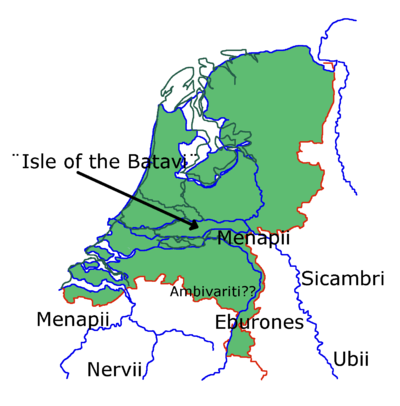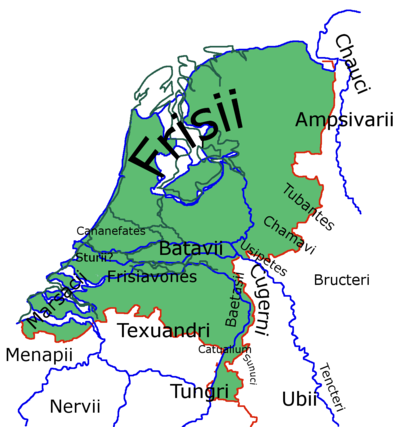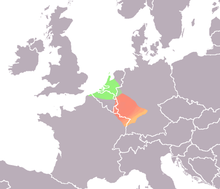Netherlands in the Roman era
| History of the Netherlands |
|---|
 |
|
|
For around 450 years, from around 55 BC to around 410 AD, the southern part of the Netherlands was integrated into the Roman Empire. During this time the Romans in the Netherlands had an enormous influence on the lives and culture of the people who lived in the Netherlands at the time and (indirectly) on the generations that followed.[1]
Early history

During the Gallic Wars, the area south and west of the Rhine was conquered by Roman forces under Julius Caesar in a series of campaigns from 57 BC to 53 BC.[2] The approximately 450 years of Roman rule that followed would profoundly change the Netherlands.
Starting about 15 BC, the Rhine in the Netherlands came to be defended by the Lower Limes Germanicus. After a series of military actions, the Rhine became fixed around 12 AD as Rome's northern frontier on the European mainland.[citation needed] A number of towns and developments would arise along this line. Perhaps the most evocative Roman ruin is the mysterious Brittenburg, which emerged from the sand at the beach in Katwijk several centuries ago, only to be buried again. These ruins were part of Lugdunum Batavorum.
The area to the south would be integrated into the Roman Empire. At first part of Gallia Belgica, this area became part of the province of Germania Inferior. The tribes already within, or relocated to, this area became part of the Roman Empire.
The area to the north of the Rhine, inhabited by the Frisii and the Chauci, remained outside Roman rule but not its presence and control. The Frisii were initially "won over" by Drusus, suggesting a Roman suzerainty was imposed by Augustus on the coastal areas north of the Rhine river.[3] Over the course of time the Frisii would provide Roman auxiliaries through treaty obligations, but the tribe would also fight the Romans in concert with other Germanic tribes (finally, in 296 the Frisii were relocated in Flanders and disappeared from recorded history).[4]
Native tribes
During the Gallic Wars, the Belgic area south of the Oude Rijn and west of the Rhine was conquered by Roman forces under Julius Caesar in a series of campaigns from 57 BC to 53 BC.[5] He established the principle that the Rhine, which runs through the Netherlands, defined a natural boundary between the Gauls and Germanic peoples. But the Rhine was not a strong border, and he made it clear that there was a part of Belgic Gaul where many of the local tribes were "Germani cisrhenani", or in other cases, of mixed origin. The approximately 450 years of Roman rule that followed would profoundly change the area that would become the Netherlands. Very often this involved large-scale conflict with the "free Germans" over the Rhine.
When Caesar arrived, various tribes were located in the area of the Netherlands, residing in the inhabitable higher parts, especially in the east and south. These illiterate tribes did not leave behind written records, so all the information known about them during this pre-Roman period is based on what the Romans and Greeks wrote about them. Julius Caesar himself, in his commentary Commentarii de Bello Gallico wrote in detail only about the southern area which he conquered. Two or three tribes who he described as living in what is now the Netherlands were:
- The Menapii, a Belgic tribe who stretched from the Flemish coast, through the south of the river deltas, and as far as the modern German border. In terms of modern Dutch provinces this means at least the south of Zeeland, at least the north of North Brabant, at least the southeast of Gelderland, and possible the south of South Holland. In later Roman times this territory seems to have been divided or reduced, so that it became mainly contained in what is now western Belgium.
- The Toxandria, the home of the Texuandri.
- The Ambivaritiwere apparently a smaller tribe, perhaps part of the Eburones, or Menapii, who Caesar mentions in passing as living west of the Maas, and therefore somewhere in or near North Brabant. (It is possible they lived in what is now Belgium.)
In the delta itself, Caesar makes a passing comment about the Insula Batavorum ("Island of the Batavi") in the Rhine river, without discussing who lived there. Later, in imperial times, a tribe called the Batavi became very important in this region. The island's easternmost point is at a split in the Rhine, one arm being the Waal the other the Lower Rhine/Old Rhine (hence the Latin name [6] Much later Tacitus wrote that they had originally been a tribe of the Chatti, a tribe in Germany never mentioned by Caesar.[7] However, archaeologists find evidence of continuity, and suggest that the Chattic group may have been a small group, moving into a pre-existing (and possibly non-Germanic) people, who could even have been part of a known group such as the Eburones.[8]
| Tribes named by Julius Caesar | Tribes during Roman empire |
|---|---|
 |
 |
Later tribes
Other tribes who eventually inhabited the "Gaulish" islands in the delta during Roman times are mentioned by Pliny the Elder:[9]
- The Cananefates, whom Tacitus says were similar to the Batavians in their ancestry (and so presumably came from Germany). These lived to the west of the Batavi, sharing the same island, in what is today the province of South Holland.
- The Frisii, who also inhabited the Netherlands north of the delta, and thus covered a major part of the modern Netherlands, not only in modern Friesland, but also in North Holland and at least in parts of all the other northern Dutch provinces today.
- The Chauci, whose main territory was the north sea coast of Germany, bordering the Frisii on their east. They are thought to be ancestors of the later Saxons, and apparently only held a small part of the modern Netherlands in Roman times.
- The Frisiabones, who Pliny also counted as a people living in Gallia Belgica, to the south of the delta. They probably therefore lived in the north of North Brabant, perhaps stretching into Gelderland and South Holland.
- The Marsacii, who Tacitus refers to as neighbours of the Batavi. Pliny also apparently mentioned these as stretching on to the Flemish coast, and they probably inhabited what is today the province of Zeeland.
- The Sturii, who are not known from any other sources, but are thought to have lived near the Marsacii, therefore in modern Zeeland or South Holland.
As mentioned above, the northern Netherlands, above the Old Rhine, was dominated by the Frisii, with perhaps a small penetration of Chauci. While this area was not officially part of the empire for any long periods, military conscription and other impositions were made for long periods upon the Frisii. Several smaller tribes are known from the eastern Netherlands, north of the Rhine:
- The Twenthein Overijssel, had units serving in the Roman army in Britain.
- The Chamavi, from Hamaland in northern Gelderland, a Frankish tribe that often fought against Rome.
- The Salians, also Franks, probably originated in Sallandin Overijssel, before they moved into the empire, forced by Saxons in the 4th century, first into Batavia, and then into Toxandria.
- South of the Chamavi and on the Rhine the Usipetes lived for some time. Caesar reported that them already in his time as newcomers from the east. Eventually they appear to have been forced southeast under pressure from the Frankish Chamavi and Chatuarii.
In the south of the Netherlands the
Batavian revolt
About 38 BC, a pro-Roman faction of the
The relationship with the original inhabitants was on the whole quite good; many
However, this did not prevent the
Other Roman soldiers (like those in
The Batavi may have merged into the Salian Frankish community, who first appear in the written record in the third century as a group who had been living in Batavia before being pushed southwards out of the delta.[12]
Roman settlements in the Netherlands
During their stay in Germania Inferior, the Romans established a number of towns and smaller settlements in the Netherlands and reinforced the Limes Germanicus with military forts. More notable towns include Ulpia Noviomagus Batavorum (modern Nijmegen) and Forum Hadriani (Voorburg).

Roman forts in the Netherlands (squares on the map)
- Flevum (at modern Velsen) A harbour has been found here as well. (Disputed)
- Lugdunum Batavorum (Brittenburg at modern Katwijk aan Zee)
- Valkenburg)
- Matilo (in the modern Roomburg area of Leiden)
- Albaniana (at modern Alphen aan den Rijn)
- Fort of an unknown name (near Bodegraven)
- Laurium (at modern Woerden)
- A fort perhaps called Fletio (at modern Vleuten)
- Traiectum (in modern Utrecht)
- Fectio (Vechten)
- Levefanum (at modern Wijk bij Duurstede)
- Carvo (at modern Kesteren in Neder-Betuwe)
- Fort of an unknown name at (Meinerswijk)
- Noviomagus (in modern (Nijmegen)
Towns in the Netherlands (triangles on the map)
A) Forum Hadriani, a.k.a. Aellium Cananefatum (modern Voorburg)
B)
C)
D)
E) Coriovallum (in modern Heerlen)
Settlements or posts (circles on the map)
F) Nigrum Pullum (modern Zwammerdam)
G) settlement of an unknown name on the Leidsche Rijn
H) Haltna (modern Houten)
I) settlement of an unknown name (modern Ermelo)
J) settlement of an unknown name (modern Tiel)
K) Roman temples (modern
L) Temple possibly devoted to Hercules Magusannus (modern Kessel, North Brabant)
M) Temple (at an area called "De lithse Ham" near Maren-Kessel, now part of Oss)[13]
N) Ceuclum (modern Cuijk)
O) Roman era tombs 2 km south of town center (modern Esch)
P)
Not marked on the map: a possible fort in modern
Franks

In the 3rd century the Franks, a warrior Germanic tribe, started to appear in the Netherlands. Their attacks happened in a time period with a catastrophic sea invasion of the area.
Another change was irreversible. During transgression phases, the sea is more aggressive than under normal circumstances. The third century saw the beginning of an era of increased violence from the sea. The canal between Lake Flevo and the Wadden Sea widened and the mud-flats of the north become wetlands. The Frisians and Chauci increased the height of the terps (the mounds on the alluvial plain on which they lived) but in vain. It seems that their country was largely depopulated, and the Frisians disappear from our sources. (It is unlikely that the inhabitants of modern Friesland are related to the ancient Frisians.).....The cause of this devastation (in Frisian lands) is easy to find: raids of a new Germanic tribe, the Franks.[15]
Modern scholars of the
The Franks eventually were divided into two groups: the
Franks appear in Roman texts as both allies and enemies (
They were forced by the confederation of the Saxons from the east to move over the Rhine into Roman territory in the fourth century. Around 310, the Franks had the region of the
At the beginning of the 5th century, the Franks became the most important ethnic group in the region, just before the end of the Western Roman Empire.
See also
Notes
- ^ The exact location of the shifting coastline in Roman times is unknown.
References
- ^ Much of this article is derived from the Dutch Wikipedia article called Romeinen in Nederland
- ^ a b Jona Lendering, "Conquest and Defeat", "Germania Inferior", https://www.livius.org/ga-gh/germania/inferior.htm#Conquest
- ISBN 978-0-434-99083-2.
- ^ Grane, Thomas (2007), "From Gallienus to Probus - Three decades of turmoil and recovery", The Roman Empire and Southern Scandinavia–a Northern Connection! (PhD thesis), Copenhagen: University of Copenhagen, p. 109
- ^ Lendering, Jona, "Germania Inferior", Livius.org. Retrieved 6 October 2011.
- ^ Caes. Gal. 4.10
- ^ Cornelius Tacitus, Germany and its Tribes 1.29
- ^ Nico Roymans, Ethnic Identity and Imperial Power. The Batavians in the Early Roman Empire. Amsterdam Archaeological Studies 10. Amsterdam, 2004. Chapter 4. Also see page 249.
- ^ Plin. Nat. 4.29
- ^ Jona Lendering, "The Batavian Revolt"
- ^ Historiae by Tacitus, 1st century AD. Translation into Dutch by the Radboud Universiteit, Nijmegen Archived 2005-11-03 at the Wayback Machine
- ^ Previté-Orton, Charles, The Shorter Cambridge Medieval History, vol. I, pp. 51–52, 151
- ^ "Omroep Brabant".
- ^ "Catualium (Heel) - Livius".
- ^ Jona Lendering: Germania inferior (Livius.org)]
- Charles William Previté-Orton. The Shorter Cambridge Medieval History, vol. I. p. 151.
- ^ Williams, 50–51.
- ^ Barnes, Constantine and Eusebius, 7.
- ^ Howorth 1884, pp. 215–216
- ^ Previté-Orton. The Shorter Cambridge Medieval History, vol. I. pp. 51–52.
Bibliography
- Howorth, Henry H. (1884). "XVII. The Ethnology of Germany (Part VI). The Varini, Varangians and Franks. Section II". JSTOR 2841727.
- Bernard Colebrander, MUST (edd.), Limes Atlas, (Uitgeverij 010, 2005 Rotterdam)
- Veen, Christel (2023). Roman period statuettes in the Netherlands and beyond: representation and ritual use in context. Amsterdam: Amsterdam University Press. ISBN 9789463729383.
- Excerpta Romana. De bronnen der Romeinse Geschiedenis van Nederland

